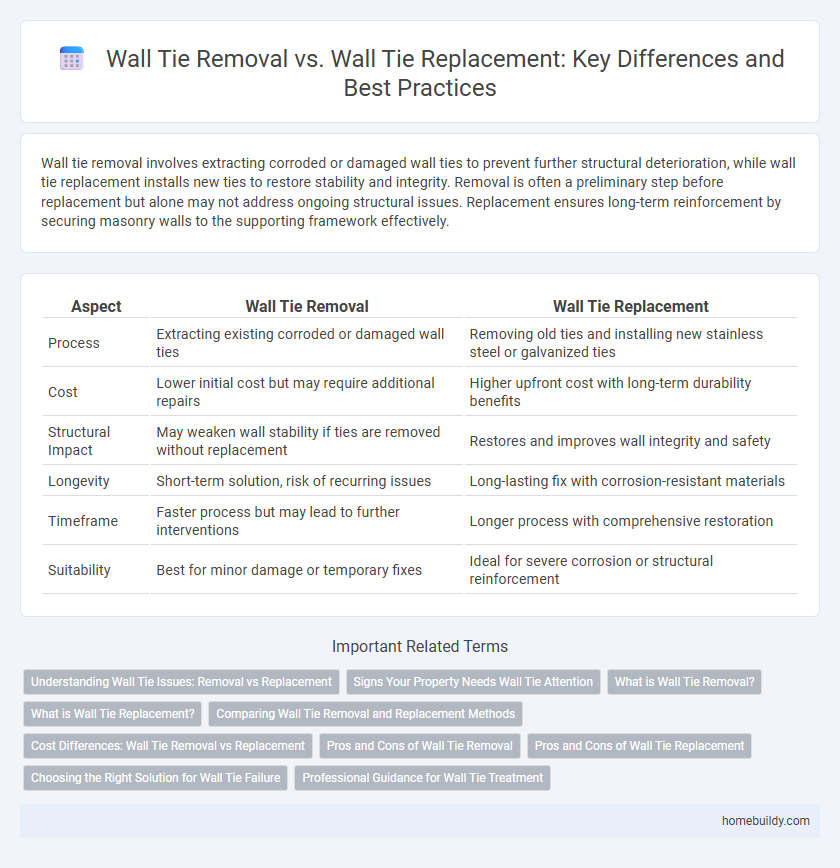Wall tie removal involves extracting corroded or damaged wall ties to prevent further structural deterioration, while wall tie replacement installs new ties to restore stability and integrity. Removal is often a preliminary step before replacement but alone may not address ongoing structural issues. Replacement ensures long-term reinforcement by securing masonry walls to the supporting framework effectively.
Table of Comparison
| Aspect | Wall Tie Removal | Wall Tie Replacement |
|---|---|---|
| Process | Extracting existing corroded or damaged wall ties | Removing old ties and installing new stainless steel or galvanized ties |
| Cost | Lower initial cost but may require additional repairs | Higher upfront cost with long-term durability benefits |
| Structural Impact | May weaken wall stability if ties are removed without replacement | Restores and improves wall integrity and safety |
| Longevity | Short-term solution, risk of recurring issues | Long-lasting fix with corrosion-resistant materials |
| Timeframe | Faster process but may lead to further interventions | Longer process with comprehensive restoration |
| Suitability | Best for minor damage or temporary fixes | Ideal for severe corrosion or structural reinforcement |
Understanding Wall Tie Issues: Removal vs Replacement
Wall tie removal involves extracting corroded or damaged ties from masonry walls, often leading to structural voids that require careful infill to maintain stability. Wall tie replacement consists of installing new, corrosion-resistant ties to restore the original load-bearing function and prevent further wall separation or bulging. Assessing the extent of corrosion and wall integrity guides the decision between removal and replacement, ensuring long-term masonry repair and building safety.
Signs Your Property Needs Wall Tie Attention
Signs your property needs wall tie attention include visible cracks in external brickwork, bulging walls, and damp patches indicating compromised structural stability. Wall tie removal might be necessary if ties are corroded beyond repair and causing masonry damage, while wall tie replacement is preferred when ties have moderately rusted but still retain structural function. Early detection through professional inspection can prevent costly repairs and preserve the integrity of retaining walls and cavity wall constructions.
What is Wall Tie Removal?
Wall tie removal involves extracting corroded or damaged wall ties from masonry walls to prevent further structural deterioration and moisture ingress. This process is often necessary when wall ties have lost their integrity due to rust or wear, posing risks to the stability of cavity walls. Wall tie removal differs from replacement by focusing solely on removing compromised ties without immediately installing new ones, which may be part of a staged repair strategy.
What is Wall Tie Replacement?
Wall tie replacement involves removing corroded or damaged wall ties and installing new stainless steel ties to restore structural integrity and prevent wall separation. Unlike wall tie removal, which leaves voids that can weaken the wall, replacement ensures the wall remains securely bonded, maintaining stability and safety. Properly executed wall tie replacement addresses corrosion issues and extends the lifespan of masonry walls in both residential and commercial buildings.
Comparing Wall Tie Removal and Replacement Methods
Wall tie removal involves extracting corroded or damaged ties to prevent structural failure, often requiring minimal disruption but risking incomplete corrosion mitigation. Wall tie replacement installs new ties to restore wall integrity and load transfer, offering a more permanent solution with higher material and labor costs. Choosing between removal and replacement depends on tie condition, structural requirements, and long-term maintenance goals.
Cost Differences: Wall Tie Removal vs Replacement
Wall tie removal typically incurs lower upfront costs due to less labor and material expenses, but may lead to structural vulnerabilities if not properly addressed. Wall tie replacement, while more expensive initially because of the need for new materials and skilled installation, ensures long-term stability and reduces risks of wall movement or collapse. Evaluating cost differences involves considering both immediate expenses and future maintenance or repair costs associated with wall integrity.
Pros and Cons of Wall Tie Removal
Wall tie removal eliminates corroded metal that can cause structural damage and dampness, reducing long-term maintenance costs and improving wall integrity. However, removing wall ties may weaken the wall's structural stability temporarily, requiring additional support or reinforcement during the process. The removal process can be labor-intensive and costly compared to wall tie replacement, which restores strength without fully dismantling existing ties.
Pros and Cons of Wall Tie Replacement
Wall tie replacement ensures structural stability by installing new, corrosion-resistant ties that restore load distribution and prevent wall bulging or collapse. This method can be costly and time-consuming, requiring invasive wall access and skilled labor, but it provides a long-term solution rather than a temporary fix. Replacing wall ties also improves building safety and value, making it preferable for severe damage compared to simple wall tie removal.
Choosing the Right Solution for Wall Tie Failure
Choosing the right solution for wall tie failure depends on the extent of corrosion and structural damage; removal is suitable for minor issues, while replacement ensures long-term stability in severe cases. Wall tie replacement involves installing new stainless steel or galvanized ties, restoring the load-bearing capacity and preventing further masonry separation. Assessing the underlying cause and consulting a structural engineer optimizes the repair strategy and safeguards building integrity.
Professional Guidance for Wall Tie Treatment
Professional guidance is essential for wall tie treatment to ensure structural safety and compliance with building standards. Wall tie removal may be suitable for severely corroded ties, but replacement with stainless steel or galvanized ties is often recommended to restore wall stability and prevent future damage. Expert assessment guarantees correct identification of tie condition and the application of appropriate repair methods, optimizing long-term building integrity.
Wall tie removal vs Wall tie replacement Infographic

 homebuildy.com
homebuildy.com